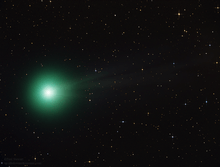Diatomic carbon
| | |
| Names | |
|---|---|
| IUPAC name
Diatomic carbon | |
| Systematic IUPAC name
Ethenediylidene (substitutive) Dicarbon(C—C) (additive) | |
| Identifiers | |
| 3D model (JSmol) |
|
| ChEBI | |
| ChemSpider | |
| 196 | |
| PubChem CID |
|
| |
| |
| Properties | |
| C2 | |
| Molar mass | 24.02 g·mol−1 |
| Except where otherwise noted, data are given for materials in their standard state (at 25 °C [77 °F], 100 kPa). | |
| Infobox references | |
Diatomic carbon (systematically named ethenediylidene and dicarbon(C—C)), also called dicarbon, is an inorganic chemical with the chemical formula C=C (also written [C
2] or C
2). It is a gas that only exists above 3,642 °C (6,588 °F)), below which it aggregates into graphite or fullerenes. It occurs in carbon vapor, for example in electric arcs; in comets, stellar atmospheres and the interstellar medium; and in blue hydrocarbon flames.[1]
Nomenclature
Dicarbon is the preferred IUPAC name. The systematic names ethenediylidene and dicarbon(C—C), valid IUPAC names, are constructed according to the substitutive and additive nomenclatures, respectively.
Ethenediylidene is viewed as ethylene with four hydrogen atoms removed. By default, this name pays no regard to the electronic state of the diatomic carbon. When the electronic state is considered, the states with no unpaired electrons are named ethenediylidene, whereas the states with two unpaired electrons are named ethenediyldiylidene, and the states with four unpaired electrons are named ethenetetrayl.
Chemistry
Molecular orbital theory shows that there are two sets of paired electrons in a degenerate pi bonding set of orbitals. This gives a bond order of 2, meaning that there should exist a double bond between the two carbons in a C2 molecule.[2] A 2012 paper by Shaik et al. has suggested that a quadruple bond exists in diatomic carbon,[3] an interpretation that was disputed by Jörg Grunenberg.[4]
Zhong et al. has proved from CASSCF(8,8) that the quadruple bond based Molecular orbital theory is also reasonable.[2]
Bond dissociation energies of B2, C2, and N2 show increasing BDE, indicating single, double, and triple bonds, respectively.
C2 is a component of carbon vapor. One paper estimates that carbon vapor is around 28% diatomic,[5] but theoretically this depends on the temperature and pressure.
Comets

The light of fainter comets mainly originates from the emission of diatomic carbon. An example is C/2014 Q2 (Lovejoy), where there are several lines of C2 light, mostly in the visible spectrum, forming the Swan bands.[6]
Properties
| Cohesive energy | 6.32 eV |
| Bond length | 1.24 Å |
| Vibrational mode | 1855 cm−1 |
The triplet state has a longer bond length than the singlet state.
Reactions
Diatomic carbon will react with acetone and acetaldehyde to produce acetylene by two different pathways.[5]
- Triplet C2 molecules will react through an intermolecular pathway, which is shown to exhibit radical character. The intermediate for this pathway is the ethylene radical. Its abstraction is correlated with bond energies.[5]
- Singlet C2 molecules will react through an intramolecular, nonradical pathway in which two hydrogen atoms will be taken away from one molecule. The intermediate for this pathway is singlet vinylidene. The singlet reaction can happen through a 1,1-diabstraction or a 1,2-diabstraction. This reaction is insensitive to isotope substitution. The different abstractions are possibly due to the spatial orientations of the collisions rather than the bond energies.[5]
- Singlet C2 will also react with alkenes. Acetylene is a major product; however, it appears C2 will insert into carbon-hydrogen bonds.
- C2 is 2.5 times more likely to insert into a methyl group as into methylene groups.[7]
Charge density
In certain forms of crystalline carbon, such as diamond and graphite, a saddle point or “hump” occurs at the bond site in the charge density. The triplet state of C2 does follow this trend. However, the singlet state of C2 acts more like silicon or germanium; that is, the charge density has a maximum at the bond site.[8]
See also
- Acetylide - a related chemical with the formula C22−
References
- ↑ Hoffmann, Roald (1995). "Marginalia: C2 In All Its Guises" (PDF). American Scientist. 83 (4): 309–311. Bibcode:1995AmSci..83..309H. JSTOR 29775475.
- 1 2 Zhong, Ronglin; Zhang, Min; Xu, Hongliang; Su, Zhongmin (2016). "Latent harmony in dicarbon between VB and MO theories through orthogonal hybridization of 3σg and 2σu". Chemical Science. 7: 1028–1032. doi:10.1039/c5sc03437j.
- ↑ Shaik, Sason; Danovich, David; Wu, Wei; Su, Peifeng; Rzepa, Henry S.; Hiberty, Philippe C. (2012). "Quadruple bonding in C2 and analogous eight-valence electron species". Nature Chemistry. 4 (3): 195–200. Bibcode:2012NatCh...4..195S. doi:10.1038/nchem.1263.
- ↑ Grunenberg, Jörg (2012). "Quantum chemistry: Quadruply bonded carbon". Nature Chemistry. 4 (3): 154–155. Bibcode:2012NatCh...4..154G. doi:10.1038/nchem.1274.
- 1 2 3 4 Skell, Philip S.; Plonka, James H. (1970). "Chemistry of the singlet and triplet C2 molecules. Mechanism of acetylene formation from reaction with acetone and acetaldehyde". Journal of the American Chemical Society. 92 (19): 5620–5624. doi:10.1021/ja00722a014.
- ↑ Mikuz, Herman; Dintinjana, Bojan (1994). "CCD Photometry of Comets". International Comet Quarterly. Retrieved October 26, 2006.
- ↑ Skell, P. S.; Fagone, F. A.; Klabunde, K. J. (1972). "Reaction of Diatomic Carbon with Alkanes and Ethers/ Trapping of Alkylcarbenes by Vinylidene". Journal of the American Chemical Society. 94 (22): 7862–7866. doi:10.1021/ja00777a032.
- ↑ Chelikowsky, James R.; Troullier, N.; Wu, K.; Saad, Y. (1994). "Higher-order finite-difference pseudopotential method: An application to diatomic molecules". Physical Review B. 50: 11356–11364. Bibcode:1994PhRvB..5011355C. doi:10.1103/PhysRevB.50.11355.
